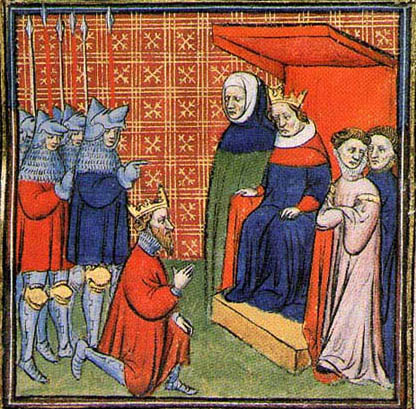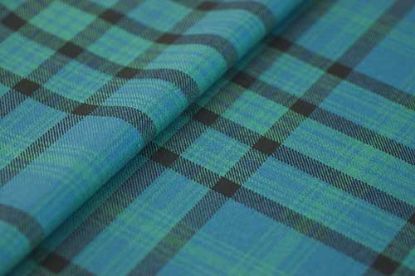Scottish Kings and Queens - John Balliol to David II.
House of Balliol (1286-1306)
 |
John Balliol, King of Scotland, offers homage to King Edward I of England, 1292. Chroniques de France ou de St Denis, illuminated manuscript, c.1400 |
GRANDSON of David, Earl of Huntingdon (younger brother of Malcolm IV and William I), and the son of the immensely wealthy Devorguilla (daughter and one of the heiresses of Alan, Lord of Galloway), John Balliol was championed by Edward I of England to become King of Scots. However, finding it impossible to comply with Edward's dictatorial demands, he rebelled in 1296. Edward promptly invaded Scotland and, following his defeat at the first Battle of Dunbar in 1296, Balliol resigned the kingdom to the Bishop of Durham, as Edward's representative, at Brechin. He was kept captive in England for three years, and then allowed to live out his days on his estates in France.
Watching as Balliol was stripped of his Royal insignia was a twenty-two year old Robert Bruce, grandson of the de Brus claimant of 1292. The young Bruce had hitherto enjoyed a close relationship with Edward I. Being large landowners in England, both he and his father had sided with Edward against Balliol.
Thereafter, Edward I of England imposed his governance over Scotland, but not without resistance. As this gained momentum, its leaders were revealed: men such as Sir William Wallace of Elderslie, and the now almost forgotten Andrew de Moravia, who died after the Battle of Stirling Bridge in which the English army was decimated. In an unprecedented step, the nobles of Scotland appointed William Wallace, Regent of Scotland.
The guerilla warfare continued for eight years, with notable Scottish defeats such as at Falkirk (1297), and Scottish victories such as the Battle of Rosslyn Glen (1303). Then in 1305, Wallace was betrayed and, taken for trial at Westminster, he was dragged through the streets of London to be hanged, drawn and quartered. It was at this stage that many Scots, appalled at the barbarity of the sentence, rose up in protest, and these included Robert Bruce who, with the death of his father, had become head of the House of Bruce. As a descendant of David I, he now claimed the Scottish throne.
House of Bruce (1306-1371)
 |
Robert the Bruce at the borestone, Bannockburn, Stirling. Charles d'Orville Pilkington Jackson (1887-1973). Bronze statue, 1964 |
NOT much is known about the early life of Scotland's hero king, but he would have been on the sidelines when the Scottish Crown was allocated to his cousin John Balliol in 1292. He was the eldest son of Robert de Brus, sixth Lord of Annandale, and Marjorie, Countess of Carrick, and his grandfather and father subsequently supported Edward I of England in the overthrow of King John, whom they regarded as a usurper.
In 1296, both the younger Robert and his father rendered homage to Edward I at Berwick-upon-Tweed. However, the former was ambivalent. He supported the Scottish revolt of the following year, relented in exchange for a pardon from Edward, he then changed his mind again with the Scottish victory at the Battle of Stirling Bridge in 1297. Edward I immediately plundered Bruce's lands in Annandale, and when Sir William Wallace, who had been appointed Guardian of Scotland, stood down following his defeat at Falkirk, Bruce and his cousin John Comyn were made Joint-Guardians of the Kingdom.
Both, however, had a serious claim to the throne of Scotland, and soon found themselves at odds with one another. In 1296, William Lamberton, Bishop of St Andrews stepped in to mediate between them, but Bruce resigned and Sir John de Soulis took over as sole-Guardian.
The conflict between Bruce and Comyn came to its climax in 1306 when the two men met at Greyfriars Church in Dumfries and Comyn was murdered. Bruce rode immediately to Scone where he was confirmed as King of Scots by the Scottish nobility. The English responded violently and Bruce went on the run, travelling through the Lowlands and to the Western Isles.
That same year, with only six hundred men, he defeated an English force ten times larger at Loudounhill. The news travelled fast and Edward I of England personally led an army north, but by then he was an old man and died on the march. His successor, Edward II of England was of a very different mould, preoccupied with his favourites at Court. In 1309, King Robert called a Parliament in St Andrews at which a peace treaty with England was proposed, but the skirmishing continued.
When Edward II finally invaded Scotland in 1314, Bruce was ready for him. At the Battle of Bannockburn the English army was soundly defeated and in the following year at Ayr, the succession of the Scottish throne was universally confirmed upon Robert Bruce, and, failing males of his body, his brother Edward and his heirs male, or failing them, Robert's daughter by his first marriage, Marjorie and her heirs. Shortly after this event, Marjorie married Walter Stewart, sixth Steward of Scotland.
King Robert had married first Isabella, daughter of the Earl of Mar, who died in 1296; secondly, Elizabeth de Burgh, daughter of the Earl of Ulster.
Although his situation was now secure, he had been excommunicated by the Pope. In 1320, the Scottish Clergy and barons petitioned Rome with the Declaration of Arbroath which declared the Nation's undying loyalty to its King. Although at first indifferent, Pope John XXII officially recognised King Robert I of Scotland in 1329, the year of his death. At the same time, the Treaty of Northampton between England and Scotland negated any claims that England still had over Scotland.
1329 -71 David II
SON of Robert I by his second marriage, David married Princess Joanna, sister of Edward III of England at the age of five. Following his father's death, however, he had to face up to an invasion from Edward Balliol and his English supporters. In 1334, he and Queen Joanna were sent to France for safety, but returning with French support to invade England in 1346, he was defeated at Neville's Cross and imprisoned for eleven years. Finally released for a ransom of 100,000 merks, he embarked upon a peaceful union with England and governed well. After Queen Joanna's death in 1362, he married the widowed Lady Margaret Logie, daughter of Sir Malcolm Drummond. Their match did not produce an heir and he divorced her six yeas later and died childless.
























